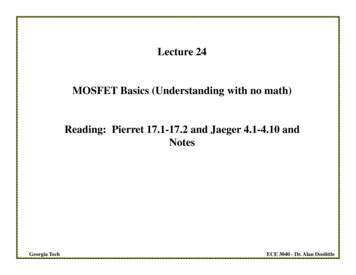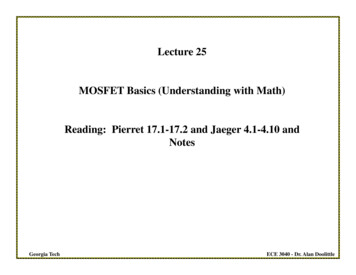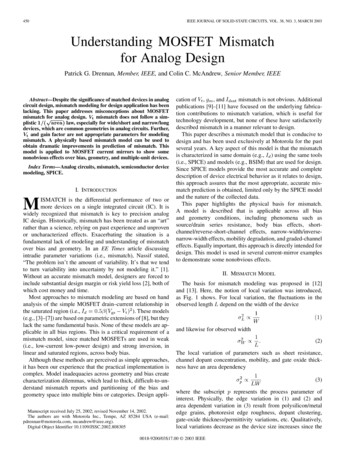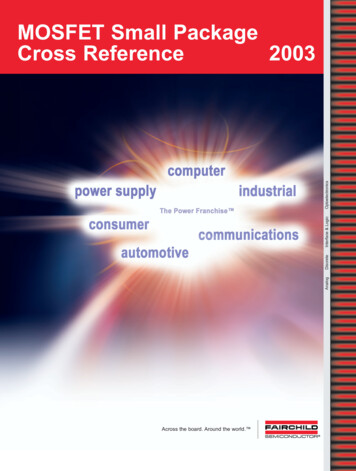
Transcription
Lecture 24MOSFET Basics (Understanding with no math)Reading: Pierret 17.1-17.2 and Jaeger 4.1-4.10 andNotesGeorgia TechECE 3040 - Dr. Alan Doolittle
MOS TransistorQualitative DescriptionFlow of current from “Source” to “Drain” iscontrolled by the “Gate” voltage.Control by the Gate voltage is achieved by modulating the conductivity of thesemiconductor region just below the gate. This region is known as the channelGeorgia TechECE 3040 - Dr. Alan Doolittle
MOS TransistorQualitative Descriptionn-channel MOSTransistorp-channel MOSTransistorDD VDSGB VBS VGSS-VSDGBVSBVSGS Note: All voltages are shown in their “positive “ direction.Obviously, VYX -VXY for any voltageG Gate, D Drain, S Source, B Body (substrate, but to avoid confusion with substrate, B is used)Georgia TechECE 3040 - Dr. Alan Doolittle
MOS TransistorQualitative DescriptionAssume an n-channel (receives it’s name from the “type” of channelpresent when current is flowing) device with its source and substrategrounded (i. e., VS VB 0 V).For any value of VDS: when VGS 0 (accumulation), the source to drain path consists oftwo back to back diodes. One of these diodes is always reversebiased regardless of the drain voltage polarity.P-type when VGS VT (depletion), there is a deficit of electrons and holesmaking the channel very highly resistive. No Drain current canflow.High due toDepletionGeorgia TechECE 3040 - Dr. Alan Doolittle
MOS TransistorQualitative DescriptionConsider now the Inversion case:First, VDS 0: when VGS VT , an induced n- type region, an“inversion layer”, forms in the channel and “electricallyconnects” the source and drain.Inversion layer (n-type)P-typeGeorgia TechECE 3040 - Dr. Alan Doolittle
MOS TransistorQualitative DescriptionInversion case, VGS VT(continued):When VDS 0 , the induced n- type region allows current toflow between the source and drain. The induced channel astlike a simple resistor. Thus, this current, ID, depends linearlyon the Drain voltage VD. This mode of operation is calledthe linear or “triode”* region.Inversion layer (n-type)P-type* “Triode” is a historical term from vacuum tube technology.Georgia TechECE 3040 - Dr. Alan Doolittle
MOS TransistorQualitative DescriptionInversion case, VGS VT(continued):Drain current verses drain voltage when in the linear or“triode”* region.Georgia TechECE 3040 - Dr. Alan Doolittle
MOS TransistorQualitative DescriptionInversion case, VGS VT(continued):When VDS increases a few tenths of a volt ( 0): The depletion region near the drain widens (N drain ispositively biased – I.e. reverse biased with respect to thesubstrate). The electron concentration in the inversion layer nearthe drain decreases as they are “sucked out” by the Drainvoltage. Channel conductance decreases resulting in a drop in theslope of the ID-VD curve. Reduced electron concentration in theInversion layer near the drainGeorgia TechP-typeECE 3040 - Dr. Alan Doolittle
MOS TransistorQualitative DescriptionInversion case, VGS VT(continued):Drain current verses drain voltage for increasing VDS (still in the“linear” or triode region).Georgia TechECE 3040 - Dr. Alan Doolittle
MOS TransistorQualitative DescriptionInversion case, VGS VT(continued):The inversion layer eventually vanishes near the drain end ofthe channel.This is called “Pinch-Off” and results in a Flat ID-VDS curveGeorgia TechECE 3040 - Dr. Alan Doolittle
MOS TransistorQualitative DescriptionInversion case, VGS VT(continued):ID-VDS curve for the “Saturation Region”The drain-source voltage, VDS, at which this occurs is called the saturationvoltage, Vsat while the current is called the saturation current, IDsat.IDsatGeorgia TechECE 3040 - Dr. Alan Doolittle
MOS TransistorQualitative DescriptionInversion case, VGS VT(continued):For VDS Vsat the channel length, L, effectively changes by avalue L.The region of the channel, L is depleted and thus, is highresistivity. Accordingly, almost all voltage increases inVDS Vsat are “dropped across” this portion of the channel.High electric fields in this region act similarly to thecollector-base junction in a BJT in active mode,“stripping” or “collecting” carriers from the channel.Georgia TechECE 3040 - Dr. Alan Doolittle
MOS TransistorQualitative DescriptionInversion case, VGS VT(continued):If L L, the voltage at the end of the channel will beconstant (Vsat ) for all VDS Vsat. ID will be constant.If L L, the voltage dropped across the the channel (VSAT)varies greatly with VDS due to large modulations in theelectric field across the pinched off region ( E [VDSVSAT]/[ L]). In this case, ID increases slightly with VDS.Georgia TechECE 3040 - Dr. Alan Doolittle
MOS TransistorQualitative DescriptionFinally,ID-VDS curves for various VGS:VDsat depends on VGGeorgia TechECE 3040 - Dr. Alan Doolittle
MOS Transistor vs MOS Capacitor Bias ModesPMOSVGSVTPNMOSVTNMOS r/Triode0Georgia TechVGSSaturationVDSATVDSECE 3040 - Dr. Alan Doolittle
Georgia Tech ECE 3040 - Dr. Alan Doolittle Lecture 24 MOSFET Basics (Understanding with no math)










